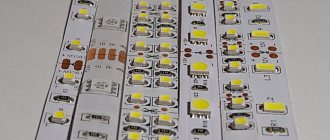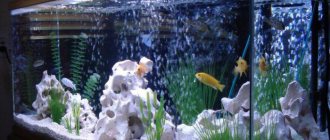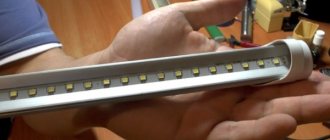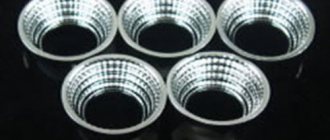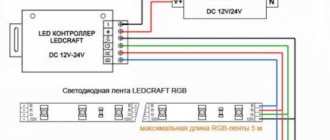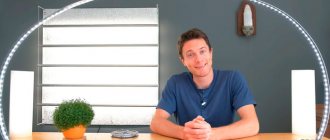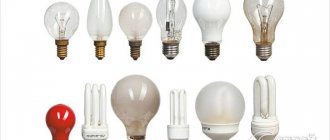4.3
(13)
When setting up an aquarium, you need to take into account many nuances. To make your home underwater world pleasing to the eye, you need to properly work out the design, select the inhabitants (and these can be not only fish), and the flora. Well, of course, the most important component in the attractiveness is the lighting of the aquarium.
Content
- 1 Why does an aquarium need special lighting?
- 2 Lighting for plants
- 3 Types of lamps 3.1 LED lighting
- 3.2 Fluorescent lamps
- 3.3 Metal halide lamps
- 3.4 Incandescent lamps
- 3.5 Mercury vapor lamps
- 4.1 Plant lamps
- 5.1 Freshwater aquarium without plants
- 6.1 Non-adjustable lighting
LED luminaire MaxSpect R420r
Why does an aquarium need special lighting?
Good lighting in the aquarium allows you to achieve the desired visual effect. The intensity of natural sunlight is very high, especially in bodies of water that are not very deep and not shaded. Theoretically, only sunlight would be ideal, but in real conditions both its intensity and day length almost always differ from tropical ones. In addition, the effect of the sun on a small aquarium environment is very difficult to control. For example, it can lead to water blooms and the walls of the aquarium becoming overgrown with green algae. Some practitioners achieve good results using sunlight, but these cases are rather exceptions and require good knowledge and experience to implement. So it is better not to place an aquarium near an unshaded window.
Ordinary room light is also not enough to illuminate an aquarium: neither in intensity nor in spectrum it is suitable for photosynthesis. In addition, in dim room light by aquarium standards, the aquarium will look very dark and not at all impressive.
Lighting for plants
The aquarium must have lighting sufficient to support the life of both fish and plants. Proper lighting solves two main problems: it allows us to admire the beauty of the aquarium and promotes the photosynthesis of green plants. Thanks to this process, organic substances are formed in plants with the participation of light energy.
Some plants survive on minimal amounts of light for photosynthesis. If the aquarium is illuminated excessively, there is a risk of unhindered proliferation of microscopic green algae, which gradually form a persistent coating on the walls of the aquarium.
Aquarium plants without light
Now, what can grow if the lighting of the aquarium is almost zero. Sometimes they say that somewhere (or at home) plants grow without specialized lamps. That everything is fine and there is no need to spend more. But just by comparing photographs of aquariums where the light is of high quality and where there is no light, everything will immediately become clear to you. This is not the normal existence of plants, since in the light they look completely different.
1 – almost no light – the lamps are not special; the following will grow: Vallisneria, Hornwort, Elodea, Cladophora.
2 – lamps for plants, but too little light, will grow: anubias nana, hygrophila loosestrife, cryptocarinae, ferns.
But just keep in mind, this is what plants that received light and plants that received little light look like.
And at the end, this is what the aquarium looks like under our light. Just launched. You can go to our aquarium channel and there you will find new versions of this aquarium.
Types of lamps
LED lightening
LEDs are still rare, but top modern LEDs already have very good efficiency and cost-effectiveness indicators. In addition, LEDs can be dimmed, that is, turned on not at full power. This allows you to create smooth sunrises and sunsets, and different types of LEDs, being connected through a multi-channel controller, allow you to adjust the required lighting color. Cost-effectiveness and compactness make it possible to create lamps for both low and very high aquariums.
Fluorescent lamps
The most common and affordable lighting method at the moment is gas-discharge fluorescent lamps. The industry produces several types of such lamps of various sizes: from the shortest to more than a meter in length.
Metal halide lamps
Metal halide lamps (HQI) - powerful (from 70 to 500 W and above). Most often referred to as "MG". They give a yellowish tint, which is compensated by adding a blue fluorescent lamp. Capable of illuminating a large column of water.
Incandescent lamps
Gone are the days when aquarists had to use ordinary household incandescent lamps. They emitted too little light and too much heat, so it was difficult to provide good illumination with reasonable power consumption.
Mercury vapor lamps
Mercury vapor lamps (HQL) are more expensive than fluorescent lamps and are used for deep tanks. They are especially useful for large marine aquariums. Mercury lamps are very powerful and produce a lot of heat, so they must be placed at least 20 cm above the surface of the water. They are rare, since due to the combination of characteristics, most aquarists prefer metal halide lamps to them.
Let's compare an LED lamp and a fluorescent lamp in an aquarium
Right away – let’s compare our lamp with the TOP Seoul diodes. The competitor is Sylvania Aquastar and Grolux lamps.
Length 60 cm. We use 2 of their lamps. The price of each is 10 USD. In 10 years you need 20 of them. (we change 2 lamps every year). Total, 200 USD The cost of a 60 cm lamp that produces 30 W. – 70 USD Yes, in the previous version I didn’t yet calculate the cost of the lamp itself. Real savings several times.
When compared with cheap lamps, then yes, fluorescent lamps win. But their quality of light is not at all the same.
Range
An aquarium can be illuminated with lamps of different spectrums. The total spectral composition of radiation is expressed in special units - degrees kelvin (°K). Daylight corresponds to 5500 °K. Takashi Amano recommends lamps with a spectrum of 8000 °K for planted aquariums. For marine aquariums, lamps with a higher color temperature are used than for freshwater aquariums.
Plant lamps
These lamps have a pinkish light and are used both in aquariums and in greenhouses. Their pink light is due to the predominance of the red and blue parts of the spectrum, most needed for photosynthesis. Lamps with a color temperature of 2400–2700 °K are used.
Warm white lamps
These lamps are yellowish in color. Such lamps have a color temperature from 3000 °K to 6000 °K and are most often found in hardware stores. Under these lamps, the aquarium appears yellow and dimly lit, so they are chosen for aquariums with low lighting, or used in combination with cool white lamps to give it warmth.
Cool white lamps
In terms of spectral composition, their light is closest to that of the sun. These lamps provide the best display of fish and underwater scenery, and also have the most natural light, so they are used either alone or in combination with other lamps to “dilute” their light and give it a “natural” look. These lamps have a color temperature of 6000 °K.
Blue lamps
They are used mainly in marine aquariums, where, in combination with other light sources, they help recreate the specific conditions of tropical oceans, while simultaneously promoting the growth of corals, which largely depend on the photosynthesis of symbiont algae. These are lamps with spectra from 10,000 °K and above.
Light intensity and daylight hours
It must be remembered that in a new aquarium you need to start with a short daylight hours and gradually increase it to the expected duration.
In this part of the article we will use such a conventional unit as W/l. The fact is that it is difficult to accurately express the intensity of illumination at a level accessible to non-specialists, but this conventional unit gives a general idea of the amount of light for aquariums with more or less classical proportions. It should be read as: “watts of fluorescent lamps per liter of aquarium water.”
Lighting for too long or too intense will cause algae to appear. Therefore, the duration of illumination is given very approximately and should be adjusted according to the results of observations.
Good LED lamps provide intensity adjustment. In all other cases, you can adjust the illumination by adjusting the distance between the lamp and the surface of the water.
Freshwater aquarium without plants
In such aquariums, lighting is needed only for the comfort of observing the aquarium. They have a sufficient illumination level of up to 0.3 W/l. The recommended daylight hours are from 6 to 12 hours.
Moderate Herbalist
To grow unpretentious plants and keep fish, use lighting at a level of 0.4-0.6 W/l. The recommended daylight hours are from 6 to 10 hours.
Overclocked Herbalist
In order to turn an aquarium into an underwater garden, lighting with an intensity of about 1 W/l is used. Such an aquarium will require some knowledge, the application of fertilizers and carbon dioxide. Read more in the article about planted aquariums. The recommended daylight hours are up to 14 hours of stepped or dimmable lighting (see below) with a peak illumination of about 4 hours.
Marine fish aquarium
Keeping fish without corals does not require strong lighting. In this case, the power and spectrum of lighting is selected to best represent the inhabitants. The recommended daylight hours are from 4 to 8 hours.
Reef Aquarium
There is usually one rule for keeping corals: the more light, the better. The fact is that in nature reefs are illuminated very brightly. If some inhabitant of a reef aquarium does not like too bright lighting, it is planted deeper, perhaps in the shade. The recommended daylight hours are about 12 hours.
Plants don't grow - add light
This is a bonus for you, dear reader. Let's reveal another truth. Ask on the aquarium forum - the plants do not grow. In 90% of cases, the answer is to install more lamps - there is not enough light. The fact that there is no point in asking on forums is a fact. There are people sitting there who heard the ringing and don’t understand where it came from. And they give advice. Even powerful brands in the aquarium industry are trying to fool you. And so, why advice is harmful. I will compare the power of the light with the engine of a car. The more powerful the engine, the faster the car moves. Logically everything is correct.
You ask on the forum why my Cossack is driving slowly, and the answer is install a new Mercedes engine. Then the question arises for us. A Zaporozhian with a Mercedes engine becomes a Mercedes and will drive 250 km/h? The answer is, of course not, his wheels will fly off at that speed. So, besides the engine, there are other parts in the car. Same thing in the aquarium. You cannot increase 1 parameter and not increase others. To make the car go faster, you need a more powerful engine, a more durable body, different wheels, and the driver’s seats need to be changed….
This horror story was invented by lamp sellers. After all, adding light is the most expensive thing you can do. Sometimes it is much cheaper to remove unsuitable stones or soil, add fertilizer, or supply CO2 for some types. But when you contact aquarium lid manufacturers with the question “why aren’t the plants growing,” in most cases you will get the answer - add light. Therefore, if we are asked such a question, the answer is the following - send photos.
Aquarium with little light
Driving at a speed of 60 km/h. The aquarium is the simplest - these are ordinary non-professional lamps of 0.1-0.3 W. liter, perhaps the aquarium is tall. Only Cryptocarynes, Anubias and Valisneria grow. All. This is an ordinary aquarium with plants. The soil is pebbly, where it is difficult for plants to cling to, water changes are rare, it is possible that you are only adding water to replace the evaporated water, the filter is so-so.
Aquarium with plants
90 km/h. You install professional lamps, but there is still little light. You already need to change the water regularly. The soil needs to be planted shallower. In addition, ferns, hygrophiles, sagitaria, some fast-growing plants, and echinodorus begin to grow.
Overclocked Herbalist
Speed 200 km/h. There is a lot of light, it is of high quality. The soil for an aquarium is just the right one. Perhaps there is already a substrate underneath. Add food for aquarium plants from time to time. Plants grow densely and almost everything except demanding ones and many types of ground cover. Water changes every week.
Super herbalist
400 km/h. Lots of bright light, constant water changes, add nutrients to both the soil and the water. And then all the time. You do not add ordinary water, but partially osmotic water. Add CO2 to the water. Constantly monitor the Psh level in the aquarium. Good filtration. You have a gorgeous herbalist where almost all plants grow that can adapt to underwater life. Anything is possible, as long as your skill is enough.
At what speed do you drive in aquarium farming?
Therefore, when they say - let's increase the number of lamps in your aquarium - people heard a ringing sound. They heard from the seller of aquarium covers that they recommended more lamps to someone - and they repeat this as if it were true. But the truth is different - the light cannot be separated from everything else in the aquarium. If you simply add more light to the aquarium, and do not increase other parameters, then your aquarium will become completely covered with greenery, absolutely all, in the corner of the room, there is probably water behind the glass. This is the same as installing a Mercedes engine for a Cossack. It still won't increase the speed.
Lighting control
There are three ways to light an aquarium.
Non-adjustable lighting
This is the simplest case of adjusting the lighting: it is either on or off. A timer is enough to organize it.
Step lighting
This is a method in which groups of lamps are turned on at the beginning of the day (and turned off at the end of the day) sequentially at certain intervals. Thus, in the middle of the daylight hours there is a short period of maximum illumination - for example, up to 4 hours. The point is that the powerful lighting required for some plants and other photosynthetics cannot be turned on for long periods of time, as this will lead to the appearance of large amounts of algae. And with stepped lighting it is possible to create a long daylight hours with a period of powerful lighting.
Dimmable lighting
The use of LEDs led to the development of the idea of stepped lighting. LEDs allow you to create daylight with a smooth change in the level of illumination from dawn to sunset.
The easiest way is when the controller is built into the lamp itself. You can set the lighting program directly on the lamp itself. Of course, if there are several lamps, you will have to configure each one separately, if the manufacturer did not take into account their connection to each other.
There is also an option to connect the lamp to an external controller. The connection occurs either via a digital line or an analogue one (0-10V). Most modern lamps without built-in controllers support this connection. This solution allows you to control several lamps at once. Some advanced controllers allow more complex lighting options: for example, taking into account the time of year and phase of the moon, simulating thunderstorms, and so on.
What to consider when choosing aquarium lamps
Experienced aquarists definitely advise that their choice be based on the lamp power and light output. All this data can be easily found on the lamp packaging. Let's see what light sources are currently on the market.
Metal halide lamps
They belong to gas-discharge lamps. Also available in the form of panels and spotlights. Their advantages include high power and long service life. But there is a limitation in use: they have to be installed on a stand or on hangers at a distance of at least 30cm from the surface of the water. The fact is that precisely because of their high power, they heat the water very much. They are suitable for you if your aquarium has a depth of more than 60 cm. These lamps will perfectly penetrate the water column and create a pleasant perception of the aquarium interior thanks to excellent color rendition.
Light source with filament
Such lamps used to be in every home. You may still be using them now. This is an ordinary light bulb. Its most important advantage is that its light is very close to sunlight, and most plants really like this. However, they are now rarely used by aquarists. And all because of high losses and low efficiency. Losses are more than 95%. There is no need to talk about the short service life. Aquarists also do not like it because of its strong heating.
LED lamps
LED technology is developing by leaps and bounds and each new generation of lamps becomes more advanced every year. They have a lot of advantages:
- economical because they use low voltage;
- safe;
- do not heat the surface of the water;
- In addition, they are as powerful as metal halide lamps.
The disadvantage of such lamps is, first of all, the price. But, due to the fact that technology does not stand still, the cost of such lamps is gradually decreasing, and they are gradually becoming common among aquarists.
Fluorescent light sources
In terms of the ratio of light and heat output, they have one of the best indicators among aquarium lamps. These HID lamps provide excellent illumination that is great for both plants and animals living in the aquarium.
T8 and T5 fluorescent lamps are very popular among aquarists. The numbers on the lamp marking indicate the diameter of the lamp tube. T5 - 5 inches, T8 - respectively, 8 inches.
